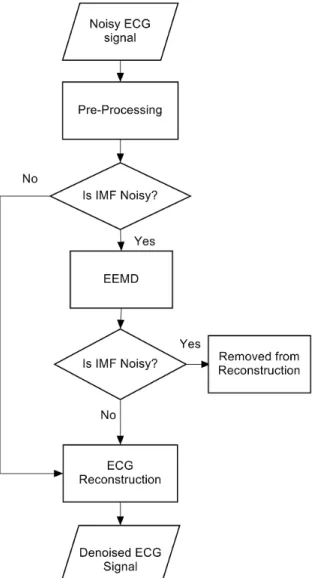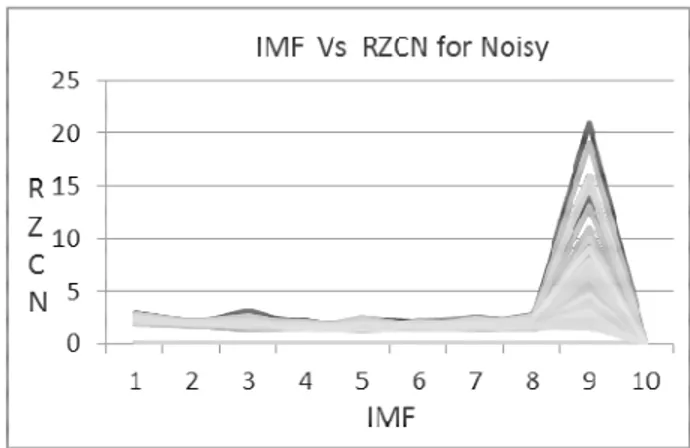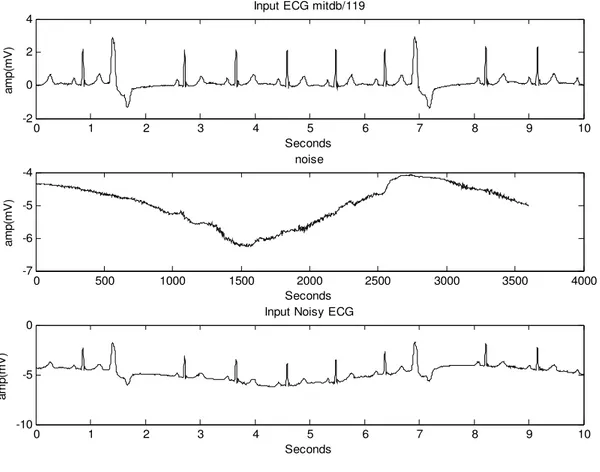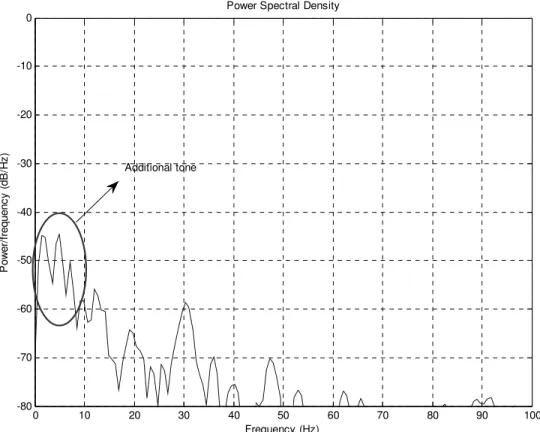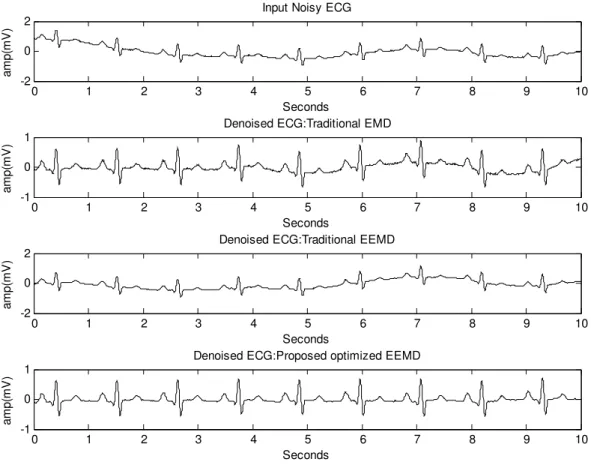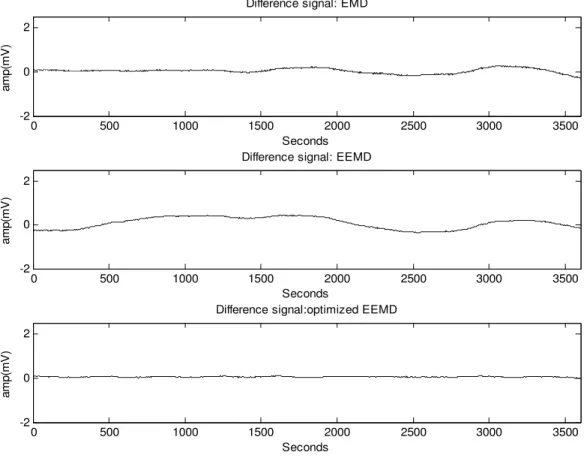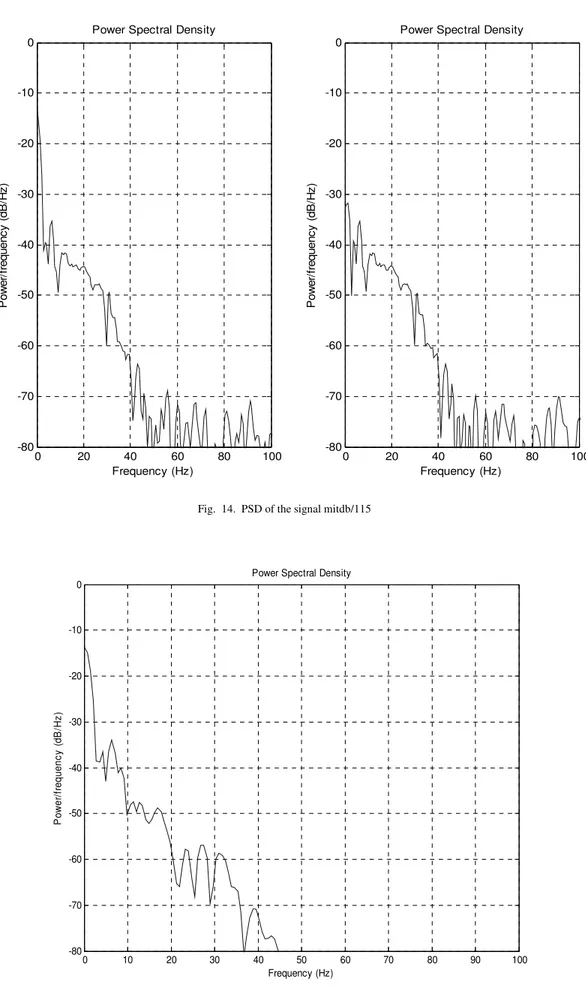Abstract— This paper proposes a novel optimized framework for baseline wander removal from the ECG signal based on Ensemble Empirical Mode Decomposition (EEMD). Computational complexity of the algorithm is one of the main factors which affects the real time monitoring of cardio activities and diagnosis of arrhythmias. The computational complexity in EEMD is significantly reduced by using the Empirical Mode Decomposition (EMD) as a pre-processing stage. Empirical Mode Decomposition decomposes the noisy ECG signal into intrinsic mode functions (IMF). The IMF components which are affected by baseline wander noise are automatically identified based on the modified Ratio of the Zero Crossing Number (RZCN) parameter. EEMD is used further to decompose only the noisy IMF components. This proposed method is evaluated using real-time ECG signals which are available at MIT-BIH arrhythmia database and simulated ECG signals using MATLAB functions. The computational efficiency of this proposed method is measured using MATLAB profiling functions, and the proposed method is compared to traditional EMD and EEMD based baseline wander removal methods. Signal to Noise Ratio (SNR), correlation coefficient (CCR) and Root Mean Square Error (RMSE) parameters are used to compare the performance of the proposed method with traditional EMD and EEMD based methods. Results show that the proposed method performs better than traditional EMD and EEMD based methods, and it is computationally more efficient than EEMD.
Index Terms—Baseline wander, Electrocardiogram (ECG), Ensemble Empirical Mode Decomposition (EEMD), Empirical Mode Decomposition (EMD)
I. INTRODUCTION
CG signal is the electrical manifestation of contractile activity of the heart and is invasively recorded using surface electrodes on the limbs and chest. ECG extensively used in the diagnosis of heart diseases. However, this valuable information is affected by various noise sources like baseline wander, power line interference and motion artifacts. Noise in ECG degrades the accuracy of diagnosis. Baseline wander (BW) noise affects almost all ECG recordings. It caused by respiration, perspiration and varying impedance between electrode and skin due to poor skin-electrode contact [1]. ECG BW noise bandwidth is in the
Manuscript received July 30, 2014 revised April 16, 2015
J. Jenitta is with Anand Institute of Higher Technology, Chennai , India (phone: 09880411553; e-mail: jenittajebaraj@gmail.com)
A.Rajeswari is with Coimbatore Institute of Higher Technology, Coimbatore, India (e-mail: rajeswari.ece.cit@gmail.com )
same range of ECG signal bandwidth. The bandwidth of the BW noise extends from 0 Hz to 0.8 Hz. So the presence of BW noise in ECG recording distorts the low-frequency ST segment of ECG signal that has strong clinical importance in the diagnosis of Acute Coronary Syndrome (ACS). A small elevation or depression in ST segment affects the diagnosis results of ACS, which is the primary cause for mortality [2]. BW also affects real time ECG monitoring and arrhythmia detection. So removal of BW noise is one of the important research areas in ECG signal processing. The problem statement of removal of BW noise from ECG signal can be formulated as: the algorithm should not distort or corrupt the useful ECG signal, and it should be computationally efficient to use in real-time ECG monitoring and arrhythmia detection applications.
Different ECG denoising methods, both linear and nonlinear methods proposed in the literature starting from traditional IIR filter [3], Weiner filter, notch filter and elliptic filters. Different wavelet transform based methods proposed in the literature for ECG denoising. The wavelet transform is not adaptive in nature and needs a basis wavelet function based on the ECG signal. Recently an adaptive filter based method [4] is proposed in the literature. In [5], Independent Component Analysis based hierarchical method is proposed to remove BW from ECG signal. Quadratic Variation Reduction (QVR) based method is proposed in [6].
Recently Empirical Mode Decomposition (EMD) based ECG denoising methods introduced. EMD decomposes the ECG signal into ‘n’ number of IMF components and a residue [7]. Based on the nature of noise present in the ECG signal, particular Intrinsic Mode Function (IMF) components excluded from ECG reconstruction. In [8], [9] to denoise the ECG signal, lower order, and higher order IMF components just excluded from the reconstruction. Because it is assumed that lower order IMF components correspond to high-frequency noise components (power line interference,) and higher order IMF components correspond to low-frequency noise (baseline wander) components. Recently Suchetha et al. [10] proposed an EMD based ECG denoising method which subtracts the higher order IMF components from the noisy ECG. EMD satisfies the completeness property [7], so subtracting the noisy IMF from the input ECG signal produces the same result as excluding the noisy IMF.
One of the major drawback of the EMD algorithm is the frequent appearance of mode mixing. Mode mixing defined as a single IMF component either consisting of signals of
An Optimized Baseline Wander Removal
Algorithm Based on Ensemble Empirical Mode
Decomposition
J. Jenitta A. Rajeswari
widely disparate scales or a signal of a similar scale residing in different IMF components. Due to mode mixing problem in EMD, higher order components contain both low-frequency baseline wander noise and low low-frequency ECG components. So excluding or subtracting the higher order IMF components removes valuable ECG components in addition to baseline wander noise and distorts the ST segment. Numerous techniques [9-13] in literature were proposed to process the lower and higher order IMF components to denoise the ECG signal irrespective of whether the IMF is noise or noise free.
A new noise-assisted data analysis (NADA) method, Ensemble EMD (EEMD) [11] proposed, to alleviate the mode mixing problem in EMD. Recently EEMD based ECG denoising methods were proposed in the literature [12]. Even though EEMD method can be used to fix the mode mixing issue, computational complexity in EEMD because of the multiple iterations is a primary concern for real-time applications. Most of the real-time ECG monitoring devices are used computationally less powerful DSP or ARM processors because of its cost effectiveness. An ECG denoising algorithm is a pre-processing algorithm which is followed by other algorithms that are used to identify different arrhythmias and heart diseases automatically. So the complexity of noise removal algorithm, in terms of computational time is an important criterion for real-time ECG monitoring applications. The optimized implementation of EMD introduced in [13], in which the author tried to optimize the EMD implementation and characterized the performance of optimization based on various lengths of ECG data sets.
The purpose of this paper is to propose a computationally efficient EEMD based BW noise removal algorithm which also improves the performance of denoising compared with the traditional EMD and EEMD based methods. Noisy IMF components are automatically identified based on a Ratio of Zero Crossing Numbers (RZCN) of each IMF component. This proposed algorithm process only the noisy IMF components, so distortion in the ECG is significantly reduced. To evaluate the performance of the proposed optimized algorithm, the ECG signals from MIT-BIH arrhythmia database used. The performance of the proposed algorithm to remove the BW noise without distorting the ECG signal is measured using the correlation coefficient (CCR) and root mean square error (RMSE) parameters. MATLAB profiling is used to measure the computation complexity of the algorithm and is compared with standard EMD and EEMD based BW removal algorithms.
This paper organized as follows: section II provides a theoretical background of EMD and EEMD decomposition and the proposed method. Performances of different methods with the experimental results are given in section III. Section IV gives the conclusion and future work.
II. METHODS
A. Empirical Mode Decomposition (EMD)
EMD is a data-driven method for the analysis of non-linear and non-stationary signal. EMD is an adaptive method which is used to decompose any data into a set of IMF components and a residue, which become the basis of representing the data. As the basis is adaptive, it usually
offers a physically meaningful representation of the underlying processes. There is no need for harmonics; therefore, EMD is ideally suited for analyzing data from non-stationary and nonlinear processes. EMD identifies the oscillatory modes of a signal by its characteristic time scale using a numerical sifting process to disintegrate empirically a signal into a finite number of hidden fundamental intrinsic oscillatory modes, that is, IMFs. In [7], the detailed procedure of decomposing a signal into IMF components is explained.
B. Ensemble Empirical Mode Decomposition (EMD)
EEMD defines the right IMF components as the mean of an ensemble of trials. In each trial, the white noise of finite amplitude is added to the signal and then EMD is applied to this signal. In [11], detailed procedure of decomposing a signal into IMF using EEMD is explained.
C. Proposed method
There are three phases in the proposed BW noise removal algorithm. Figure 1 shows the flowchart of the proposed algorithm.
Fig. 1. Flowchart of the proposed optimized baseline wander noise removal algorithm based on EEMD
database and simulated ECG data sets. The MIT-BIH database [15], [16] consists of 48 half hour excerpts of two channels ambulatory ECG recordings, which were obtained from 47 subjects, including 25 men aged 32–89 years, and women aged 23–89 years. The recordings were digitized at 360 samples per second per channel with 11-bit resolution over a 10mV range. For the evaluation of the proposed algorithm, mitdb/119 ECG data is used which is not affected by any of the noise sources. The proposed algorithm is also tested with the ECG signals generated by the MATLAB ECG functions.
The real BW noise is available at MIT-BIH noise stress test database. Each noise recording is of 30 minutes duration. This real noise is added to the ECG data sets to construct a baseline wander noise affected ECG signal that acts as an input to the proposed algorithm. A random portion of the real BW noise, each with 10 second duration is added to the noise-free ECG. We have created 200 such ECG dataset with baseline wander noise. Proposed baseline wander removal algorithm is evaluated with these 200 baseline wander noise affected ECG dataset.
2) Pre-processing stage: In our proposed method, EMD is used as a pre-processing stage. EMD decomposes the input noisy baseline wander corrupted ECG data into ‘n’ number of IMF components and a residue.
3) Noisy IMF Identification: Simple ratio of zero crossing number (RZCN) parameter is used to identify the noisy IMF component. Moghtaderi, A., et al. [14] explains the RZCN based approach to identify the noisy IMF components in a broadband process. The experiment is conducted with 100 baseline wander noise added ECG, and 100 baseline wander noise free ECG signals. Each randomly selected ECG segment is of length 10 seconds duration. EMD is used to decompose the selected ECG segments into IMF components, and RZCN parameter is calculated based on equation 1. For a given data set, the Zero Crossing Number (ZCN) of the IMF is denoted by Zi;then the RZCN parameter is calculated using (1).
(1) where Ri is the ith ratio of the zero crossing number. Figure 2 shows the result of the experiment with noiseless ECG signal. RZCN of each IMF is plotted for each iteration, and it clearly shows that the average RZCN of the noiseless signal lies in the range of 1.5 to 2.5. Figure 3 shows that the average RZCN of the signal with BW noise. RZCN of IMF component IMF 9 is very high, but for all other IMF components RZCN is within the range. Based on this experiment we have selected the threshold as [1.5, 2.5], and if the RZCN of a particular IMF is above this threshold, then it is considered as noisy IMF
4) Baseline wander removal: The IMFs, which are identified as noisy IMF in the preprocessing stage, is used to construct a new input data to the EEMD algorithm. EEMD algorithm is used to decompose this new data into ‘n’ number of IMF components and a residue. EEMD algorithm fixes the mode mixing issue which is present in EMD. RZCN is used to identify the noisy IMF component, and it is removed from ECG reconstruction. Noise removed output ECG is constructed by adding the noiseless IMF components
from the pre-processing stage and the EEMD decomposition stage.
Fig. 2. IMFs Vs RZCN: Noiseless ECG signal
Fig. 3. IMFs Vs RZCN: Noisy ECG signal
5) Performance metrics: Performance of the proposed ECG denoising algorithm is evaluated using Signal to Noise Ratio (SNR), Correlation Coefficient (CCR) and Root Mean Square Error (RMSE). Computational complexity of the proposed algorithm is compared with a conventional EMD algorithm and traditional EEMD algorithm based on computation time. The performance of the proposed method is also subjectively compared with the recently proposed EMD based Iterative Interval Thresholding (EMD-IIT) [17] noise removal algorithm. Computation time is measured using MATLAB profiling functions. Equation2 to 4 gives the formulae for performance evaluations.
(2)
(3)
In all these equations x (n) is the input ECG signal from MIT-BIH database and x’ (n) is the denoised output signal.
III EXPERIMENTAL RESULTS
The proposed algorithm is implemented and tested using MATLAB software.
A. Baseline Wander removal with MIT_BIH 119
In this experiment, we have evaluated 100 ECG segments which are corrupted by Baseline wander noise. One such noisy ECG dataset of 10 second duration is shown in figure 4. EMD decomposes the baseline wander noise affected input ECG signal into 7 IMF components and a residue. The number of IMF components depends on the input data set. Figure 5 shows the generated IMF components and the residue in the pre-processing stage. The lower order IMF
corresponds to Powerline interference whereas the higher order IMF corresponds to Baseline wander noise. The output
of the traditional EMD algorithm, EEMD algorithm, and the proposed algorithm is shown in figure 6. In traditional EMD and EEMD methods, the residue component is just rejected from reconstruction. The baseline wander noise is removed along with the ECG signal’s information so, distortion is introduced in the output of EMD based baseline wander
removal method. EEMD solves the mode mixing issue, so the performance of the EEMD methods is improved when compared to EMD method. Figure 7 shows the difference
signals between original and restored signals of all three methods. The difference signal of proposed
algorithm is around the DC line, but the difference of EMD and EEMD based methods are high. It shows that the proposed algorithm is effectively eliminating the BW noise compared to EMD and EEMD methods. PSD of ideal signal and the noisy ECG signal is plotted in figure 8 and 9 respectively. A circle indicates the tone that is introduced by the added BW noise in figure 9. The PSD of the restored ECG signal is plotted in figure 10. From the PSD, it is clear that the additional tone which corresponds to BW noise is effectively removed in the restored ECG spectrum, without disturbing the other tones
The relative performance of the proposed algorithm is measured with SNR, CCR and MSE and is shown for few randomly selected datasets in TABLE I. To summarize the result, average SNR, RMSE and CCR is calculated and it is listed in the last row of the table. From the numerical results, it is very clear that the traditional EEMD method improves the performance by around 0.2dB compared to EMD method. Proposed method improves the performance by 1dB compared to EMD method and 0.9dB compared to EEMD based method.
0 1 2 3 4 5 6 7 8 9 10
-2 0 2 4
Input ECG mitdb/119
Seconds
a
m
p
(m
V
)
0 500 1000 1500 2000 2500 3000 3500 4000
-7 -6 -5 -4
noise
Seconds
a
m
p
(m
V
)
0 1 2 3 4 5 6 7 8 9 10
-10 -5 0
Input Noisy ECG
Seconds
a
m
p
(m
V
)
1 2 3 4 5 6 7 8 9 10 -0.5
0 0.5
IM
F
1
Input ECG IMF
1 2 3 4 5 6 7 8 9 10
-0.4
-0.20
0.2 0.4
IM
F
2
1 2 3 4 5 6 7 8 9 10
-0.50
0.5
IM
F
3
1 2 3 4 5 6 7 8 9 10
-1
-0.50
0.5
IM
F
4
1 2 3 4 5 6 7 8 9 10
-0.5 0 0.5
IM
F
5
1 2 3 4 5 6 7 8 9 10
-0.4
-0.20
0.2 0.4
IM
F
6
1 2 3 4 5 6 7 8 9 10
-0.2 0 0.2
IM
F
7
1 2 3 4 5 6 7 8 9 10
-0.4
-0.20
0.2 0.4 0.6
R
e
s
id
u
e
Fig. 5. IMF components of the baseline wander noise corrupted ECG data using the pre-processing stage
0 1 2 3 4 5 6 7 8 9 10
-2 0 2 4
Denoised ECG:Traditional EMD
Seconds
a
m
p
(m
V
)
0 1 2 3 4 5 6 7 8 9 10
-2 0 2 4
Denoised ECG:Traditional EEMD
Seconds
a
m
p
(m
V
)
0 1 2 3 4 5 6 7 8 9 10
-2 0 2 4
Denoised ECG:Proposed optimized EEMD
Seconds
a
m
p
(m
V
)
500 1000 1500 2000 2500 3000 3500 -0.2
0 0.2
Differnce between Input and EMD output
samples
a
m
p
(m
V
)
500 1000 1500 2000 2500 3000 3500
-0.2 0 0.2
Differnce between Input and EEMD output
samples
a
m
p
(m
V
)
500 1000 1500 2000 2500 3000 3500
-0.2 0 0.2
Differnce between Input and Proposed Optimized EEMD output
samples
a
m
p
(m
V
)
Fig. 7. The Difference signal of Noisy input and output of the signal mitdb/119
0 10 20 30 40 50 60 70
-80 -70 -60 -50 -40 -30 -20 -10 0
Frequency (Hz)
P
o
w
e
r/
fr
e
q
u
e
n
c
y
(
d
B
/H
z
)
Power Spectral Density
0 10 20 30 40 50 60 70 80 90 100 -80
-70 -60 -50 -40 -30 -20 -10 0
Frequency (Hz)
P
o
w
e
r/
fr
e
q
u
e
n
c
y
(
d
B
/H
z
)
Power Spectral Density
Additional tone
Fig. 9. The PSD of noisy input:mitdb/ 119
0 10 20 30 40 50 60 70 80 90 100
-80 -70 -60 -50 -40 -30 -20 -10 0
Frequency (Hz)
P
o
w
e
r/
fr
e
q
u
e
n
c
y
(
d
B
/H
z
)
Power Spectral Density
TABLE I
COMPARISON OF PERFORMANCE OF EMD, EEMD AND PROPOSED OPTIMIZED EEMD METHODS
Noise Segment
SNR CCR RMSE
EMD EEMD Proposed
EEMD EMD EEMD
Propose
d EEMD EMD EEMD
Propose d EEMD
147 19.6930 19.8624 20.6295 0.9285 0.9289 0.9347 0.1878 0.1862 0.1792
164 15.7536 15.9364 15.2869 0.8949 0.8953 0.8899 0.2287 0.2266 0.2341
23 19.6726 16.5902 19.1688 0.9277 0.9014 0.9239 0.1880 0.2193 0.1928
114 18.2959 18.3424 19.3280 0.9169 0.9169 0.9252 0.2014 0.2009 0.1912
18 17.4674 15.7932 19.2563 0.9088 0.8910 0.9242 0.2099 0.2282 0.1919
99 18.3133 17.8884 16.8143 0.9165 0.9128 0.9029 0.2012 0.2055 0.2168
174 16.6858 19.3288 20.3737 0.9104 0.9250 0.9332 0.2182 0.1912 0.1815
29 16.2273 15.0537 13.4118 0.8967 0.8867 0.8675 0.2233 0.2368 0.2571
175 8.6388 12.1768 14.8681 0.8048 0.8561 0.8850 0.3264 0.2734 0.2390
88 10.8021 16.4542 10.9204 0.8424 0.9028 0.8489 0.2929 0.2208 0.2912
145 23.2232 19.9330 24.1088 0.9497 0.9294 0.9541 0.1574 0.1855 0.1506
76 17.1877 17.0571 20.9816 0.9092 0.9047 0.9367 0.2128 0.2142 0.1761
Average 16.8301 17.0347 17.9290 0.9006 0.9043 0.9105 0.2207 0.2157 0.2085
0 1 2 3 4 5 6 7 8 9 10
-2 0 2
Input Noisy ECG
Seconds
a
m
p
(m
V
)
0 1 2 3 4 5 6 7 8 9 10
-1 0 1
Denoised ECG:Traditional EMD
Seconds
a
m
p
(m
V
)
0 1 2 3 4 5 6 7 8 9 10
-2 0 2
Denoised ECG:Traditional EEMD
Seconds
a
m
p
(m
V
)
0 1 2 3 4 5 6 7 8 9 10
-1 0 1
Denoised ECG:Proposed optimized EEMD
Seconds
a
m
p
(m
V
)
0 500 1000 1500 2000 2500 3000 3500 -2
0 2
Difference signal: EMD
Seconds
a
m
p
(m
V
)
0 500 1000 1500 2000 2500 3000 3500
-2 0 2
Difference signal: EEMD
Seconds
a
m
p
(m
V
)
0 500 1000 1500 2000 2500 3000 3500
-2 0 2
Difference signal:optimized EEMD
Seconds
a
m
p
(m
V
)
Fig. 12. ECG generated by MATLAB function: Difference signal of noisy input and output of all methods
0 20 40 60 80 100 -80
-70 -60 -50 -40 -30 -20 -10 0
Frequency (Hz)
P
o
w
e
r/
fr
e
q
u
e
n
c
y
(
d
B
/H
z
)
Power Spectral Density
0 20 40 60 80 100
-80 -70 -60 -50 -40 -30 -20 -10 0
Frequency (Hz)
P
o
w
e
r/
fr
e
q
u
e
n
c
y
(
d
B
/H
z
)
Power Spectral Density
Fig. 14. PSD of the signal mitdb/115
0 10 20 30 40 50 60 70 80 90 100
-80 -70 -60 -50 -40 -30 -20 -10 0
Frequency (Hz)
P
o
w
e
r/
fr
e
q
u
e
n
c
y
(
d
B
/H
z
)
Power Spectral Density
Fig. 16. Comparison of computation time of traditional EMD, traditional EEMD, and proposed optimized method.
A.Baseline Wander removal with Simulated ECG
In this experiment, the proposed algorithm is tested with ECG signals that are generated by MATLAB functions.
Input noisy ECG signal and the restored ECG signal are plotted in figure 11. To show the performance of the proposed algorithm, in time domain difference signal is calculated, and it is plotted in figure 12. It is clear that the difference signal for the proposed method is very close to DC line and for EMD and EEMD method the difference signal shows a lot of variation. It shows that the proposed method performance is better than EMD and EEMD based methods. SNR is measured for all three different methods, and it is tabulated in TABLE 2. The proposed method improves the performance by 6dB compared to EEMD based method and 9dB compared to EMD based method. In Table 2, some of the SNR values of EMD and EEMD methods have negative values, because in these signals, the last IMF is not a noisy IMF but simply eliminated from reconstruction of the output ECG signal. So, heavy distortion is introduced into the output of those signals, but the last IMF is not excluded in our proposed method.
B.Baseline Wander removal with real ECG
In this experiment, the proposed optimized algorithm is tested using an actual baseline wander noise corrupted ECG signal from MIT-BIH database. We have selected mitdb/115 which is corrupted by BW noise. This signal is an ECG record of a 39-year-old, female patient. This record is of 30 minutes duration, and it is affected by BW noise in the 16th minute of the recording. This BW noise affected ECG record is used to test our proposed EEMD based optimized algorithm. The BW noise corrupted segment is selected based on the annotation available in the MIT-BIH database and is plotted in figure13. Presence of baseline wander noise is visible in the plot, and the output signal of the proposed algorithm is better than the traditional EMD and EEMD based methods.
The performance of the proposed method in the frequency domain using PSD plot is plotted in figure 14. The baseline wander noise introduced a very low frequency component, and the proposed method removes this low-frequency component. All other frequency components are not altered. Proposed EEMD based method is compared with the recently proposed EMD - Iterative Interval thresholding (EMD-IIT) method [17]. The EMD-IIT method is using EMD concepts with thresholding technique to remove the noise. The performance of this method in the frequency domain is plotted in figure 15. High-frequency components from 45Hz are completely removed. It is clear that this method is not suitable for the removal of noise in ECG signal
C.Computational complexity
TABLE II SNR OF THE PROPOSED ALGORITHM FOR ECG GENERATED BY MATLAB FUNCTIONS
Noise Segment
SNR
EMD EEMD Proposed
EEMD
6 19.78103 14.92871 19.6915 23 16.94957 18.91395 21.31337 114 11.76688 17.66202 18.83243 18 17.31262 15.57111 17.82169 99 0.817793 6.756561 17.79537 175 -5.15044 -1.31414 17.97497 88 -8.3775 -0.36345 18.83184 145 20.90185 21.32131 19.44307 76 11.6141 16.61783 19.93671 52 10.43845 12.76531 12.39926
Average 9.6054 12.2859 18.4040
IV CONCLUSION
In this paper, a novel optimized algorithm to remove baseline wander noise in ECG signal is proposed based on EEMD. The performance of the proposed algorithm is demonstrated on real-time ECG data sets from the MIT-BIH database. Results show that the proposed algorithm performs better than traditional EMD and EEMD based methods. SNR, CCR and RMSE of the proposed optimized EEMD based method is improved by 10%, and the computation time is reduced by 55% when compared to traditional EEMD based baseline wander noise removal methods. These results show that the proposed method is computationally more efficient than the traditional EMD and EEMD based methods. In the future, this proposed method can be extended to eliminate all the artifacts from ECG.
REFERENCES
[1] Rangaraj M.Rangayan.L, Biomedical Signal Analysis: A Case-Study
Approach, Wiley-IEEE Press, December 2001.
[2] Sgarbossa EB, Pinski SL, Gates KB et al., “Early electrocardiographic diagnosis of acute myocardial infarction in the presence of ventricular paced rhythm” , The American journal of Cardiology, vol. 77, pp. 423–424, 1996.
[3] G Mahesh S Chavan, R A Agarwala, M D Uplane, “Suppression of Baseline Wander and power line interference in ECG using Digital IIR Filter”, International Journal on circuits, Systems and signal Processing, issue 2, Vol. 2, 2008.
http://www.naun.org/main/NAUN/circuitssystemssignal/index.html [4] Muhammad Zia Ur Rahman, RafiAhamedShaik, D.V.Rama Koti
Reddy, “Efficient sign based normalized adaptive filtering techniques for cancelation of artifacts in ECG signals: Application to wireless biotelemetry”, Signal Processing (2011)225–239.
[5] Yyurong Luo, Rosalyn H. Hargraves, Ashwin Belle, et al., “A Hierarchical Method for removal of Baseline Drift from biomedical Signals: Application in ECG analysis”, The Scientific World Journal, Vol. 2013.
http://dx.doi.org/10.1155/2013/896056
[6] Antonio Fasano, Valeria Villani, “Baseline wander Removal in ECG and FHA recommendation”, Computers in Cardiology, 2013 [7] N. E. Huang, Z. Shen, S. R. Long, et al., “The empirical mode
decomposition and the Hilbert spectrum for nonlinear and non-stationary time series analysis,” Proc. Roy. Soc. Lond. A, Math. Phys. Sci., vol. 454, pp. 903-995, Mar. 1998.
[8] Na Pan, Vai Mang I, Mai Peng Un Pun Sio hang, “Accurate Removal of Baseline Wander in ECG Using Empirical Mode Decomposition”, Proceedings of NFSI & ICFBI 2007, October 12,2007, Hangzhou, China.
[9] Anil Chacko and Samit Ari, “Denoising of ECG signals using Empirical Mode Decomposition based technique”, IEEE International Conference on Advances in Engineering, Science and Management proceedings, March 2012.
[10] M.Suchetha and N.Kumaravel, “Empirical mode Decomposition – based subtraction techniques for 50Hz interference reduction from Electrocardiogram”, IETE journal of research, Issue 1, Vol.59, Jan-Feb 2013
[11] Wu. Z, Huang N.E., “Ensemble empirical mode decomposition: A noise-assisted data analysis method” , Adv. Adapt. Data. Anal. 1, 1-41, 2009.
[12] Kang-Ming Chang, “Arrhythmia ECG Noise Reduction by Ensemble Empirical mode decomposition”, Sensors, 10, 6063-6080, 2010.
[13] Alexandros Karagiannis and Philip Constantinou, “Performance investigation of Empirical Mode Decomposition in Biomedical Signals”, Wireless Mobile Communication and Healthcare, Lecture Notes of the Institute for Computer Sciences, Social Informatics and Telecommunications Engineering, pp 117-124, 2011, Volume 55.
http://link.springer.com/chapter/10.1007%2F978-3-642-20865-2_16 [14] Azadeh Moghtaderi, Patrick Flandrin,Pierre Borgnat, “Trend
Filtering via Empirical Mode Decompositions”, Journal of computational statistics and data analysis, February 2011. [15] The MIT-BIH Arrhythmia Database [Online]. Available at:
http://physionet.org/physiobank/database/mitdb/
[16] Goldberger AL, Amaral LAN, Glass L, Hausdorff JM, et al., “PhysioBank, PhysioToolkit, and PhysioNet: Components of a New Research Resource for Complex Physiologic Signals”, Circulation 101(23):e215-e220 , June 13, 2000
http://circ.ahajournals.org/content/101/23/e215.full.pdf+html
[17] Yannis Kopsinis, Stephen McLaughlin, “Development of EMD-based Denoising methods inspired by wavelet Thresholding”, IEEE Transactions on Signal Processing, Vol.57, No.4, April 2009
J.Jenitta received her Master degree in Applied Electronics from Karunya University in 2006 and a Bachelor degree in ECE from Manonmanium Sundaranar University in 2004. She is currently working in Anand Institute of Higher Technology, Chennai, India in the department of ECE. Her areas of interest include Digital signal processing and Image Processing.
